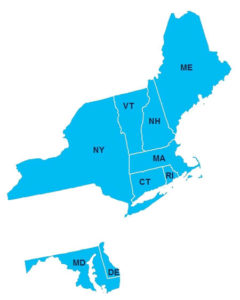“Reggie” Doubles Down in New England
The nine Northeastern and MidAtlantic states of the Regional Greenhouse Gas Initiative (RGGI) announced in late August that they have agreed on a proposal to continue to use cap and trade program and to cut GHGs from the region’s power plants by an additional 30% between 2020 and 2030.

RGGI States
The extension of “cap and trade” in New England has been seen as a test case for how states will continue their focus on climate protection. The RGGI states, together represent the world’s sixth largest economy, with $2.8 trillion in GDP. California – which recently extended its program is slightly smaller, a $2.5 trillion economy. “With the Trump administration making every effort to turn back the clock of environmental progress, it falls to state and regional collaboration to lead the way in protecting public health and defending clean air and water,” noted Conservation Law Foundation attorney Phelps Turner.
RGGI got bipartisan support for its new goals, goals that will lower emissions caps by 3% over the previous year versus the current plan’s 2.5% drop. If the proposal is approved and enacted, GHG emissions in the RGGI compact will be 65% lower in 2030 than they were in 2009. Already, according to an Acadia Center study, emissions have fallen more than 40% compared to 2008 levels.
Under the RGGI model, the coalition sets a cap on carbon pollution that declines each year. Each year, the states sell a decreasing number of permits – or allowances — at auction. Power plant operators purchase the allowances or trade them in the marketplace, enabling them to remain under the cap. The proceeds from the auctions are rolled into energy efficiency and renewable energy initiatives and programs.
